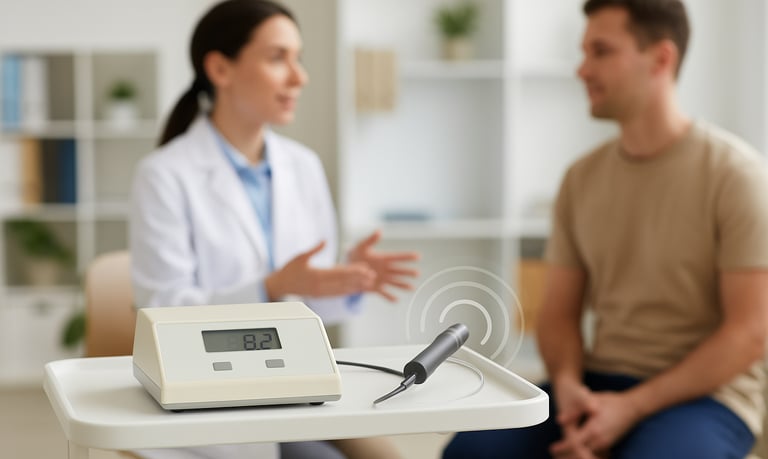Biothesiometry Technology for Diagnosis of Erectile Dysfunction
Erectile dysfunction (ED) is a multifaceted condition often linked to underlying neuropathic and vascular complications. Traditionally, neurology and electrophysiology have relied on a variety of diagnostic tests to assess nerve function. Recently, biothesiometry—a non-invasive method to measure the vibration perception threshold (VPT)—has emerged as a promising tool in the evaluation and management of ED. This blog explores the science behind biothesiometry, its application in diagnosing erectile dysfunction, and its potential impact on patient care.
medtechoptions.com
4/5/20253 min read


What Is Biothesiometry?
Biothesiometry is a diagnostic technique that quantitatively assesses the sensitivity of peripheral nerves by determining the vibration perception threshold. The device applies controlled vibrations to the skin, and the patient indicates when they first perceive the sensation. The resulting numerical value represents the VPT. Under normal conditions, this threshold falls within a predictable range; however, when nerve damage or dysfunction occurs—as is often seen in conditions like diabetic neuropathy—the threshold value increases.
How Does Biothesiometry Work?
Device Setup:
A biothesiometer is typically a handheld device that produces vibrations at varying intensities. The clinician places the probe on specific areas of the patient’s body, such as the foot, hand, or penile region.Testing Protocol:
The procedure is straightforward and non-invasive. The clinician gradually increases the vibration intensity until the patient reports the sensation. The minimal intensity that is perceived is recorded as the VPT.Interpretation of Results:
Elevated VPT values suggest reduced nerve sensitivity, which may indicate neuropathic changes. In the context of erectile dysfunction, these changes can be reflective of underlying conditions that affect the penile nerves and vasculature.
Biothesiometry and Erectile Dysfunction
Nerve Function and ED
Erectile function is closely linked to the integrity of the nervous system. The penile tissue relies on a well-coordinated interaction between the nerves and blood vessels to achieve and maintain an erection. Conditions that impair nerve function, such as diabetic neuropathy, often result in higher VPT values, indicating that a greater level of stimulus is needed for nerve activation. In patients with ED, biothesiometry can:
Identify Neuropathic Changes:
A higher-than-normal VPT suggests that the nerves responsible for sensation—and by extension, erectile function—may be compromised.Stage Disease Progression:
Since the test provides numerical data, clinicians can monitor changes over time. Rising VPT values might signal worsening nerve function and, consequently, an advancement in ED severity.
Advantages of Using Biothesiometry in ED Diagnosis
Non-Invasive and Painless:
Unlike some diagnostic tests, biothesiometry does not involve needles or incisions, making it a comfortable option for patients.Objective Quantification:
The numerical nature of the VPT measurement allows for precise staging of nerve function loss, aiding in both diagnosis and treatment planning.Rapid and Cost-Effective:
The test is relatively quick to administer and cost-effective compared to other electrophysiological studies.Potential for Early Detection:
By identifying subclinical neuropathic changes, biothesiometry may allow for earlier intervention, potentially halting or reversing the progression of ED.
Clinical Evidence and Future Directions
Emerging research has begun to validate the role of biothesiometry in evaluating erectile dysfunction. Studies comparing VPT values between healthy individuals and those with ED have consistently found that elevated thresholds correlate with the presence and severity of erectile dysfunction. Furthermore, ongoing research is exploring the integration of biothesiometry with other diagnostic modalities—such as penile Doppler ultrasound—to develop a comprehensive diagnostic algorithm for ED.
As our understanding of the neuropathic mechanisms underlying erectile dysfunction improves, biothesiometry may also serve as a useful tool in monitoring the effectiveness of treatments aimed at restoring nerve function. Future advancements could include automated data analysis and integration with electronic health records, further streamlining the diagnostic process.
Conclusion
Biothesiometry represents an exciting frontier in the diagnostic evaluation of erectile dysfunction. By providing a quantifiable measure of nerve function through the vibration perception threshold, this technique offers clinicians a reliable, non-invasive method to detect neuropathic changes associated with ED. Its ability to objectively stage disease progression not only aids in diagnosis but also supports personalized treatment strategies. As further research unfolds, biothesiometry may become an integral part of the diagnostic toolkit in both neurology and sexual medicine.
References
Adam Wiggins; M. Ryan Farrell; Peter Tsambarlis; Laurence A Levine 2019: The Penile Sensitivity Ratio: A Novel Application of Biothesiometry to Assess Changes in Penile Sensitivity
Bart L.H. Bemelmans et al 1995: Comparison of Biothesiometry and Neurourophysiological Investigations for the Clinical Evaluation of Patients with Erectile Dysfunction
